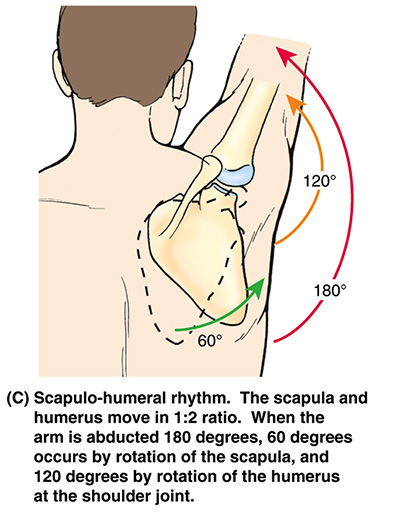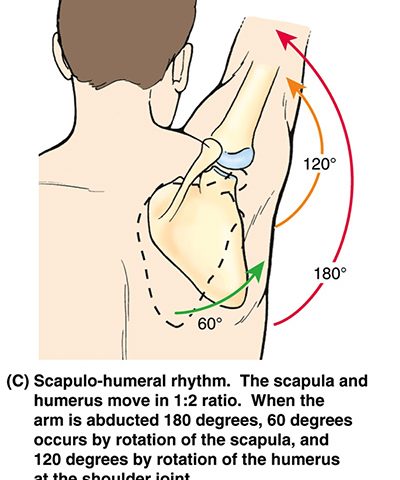Overhead training and pain

Pronation vs. Supination
April 13, 2017
What is chronic neck pain ?
April 25, 2017To have optimal pain free overhead position doesn’t always mean that you need more flexibility in fact it can be the opposite, instable shoulders can create limitations in our overhead positions. If an athlete is to have a strong, pain free overhead position, the shoulder blade and the upper back must have a healthy relationship.
A lot of exercise programming lately tends to advocate exercises that require maximal shoulder end-range motions: pull-ups (often with a kip or a jerk motion at end range), handstand presses, press squats, push-presses, clean and presses, kettlebell overhead lifting, gymnastic ring work and other similar exercises.
To perform these without creating injury requires optimal end range shoulder mobility and optimum shoulder stability. It is possible to say that these exercises help to create coordinated athletic patterns of strength, agility, and stamina, it would also be logical to say they still have a strong potential for causing / creating shoulder injuries.
Often when programming overhead workouts it is not understood or explained that these types of workout programs demand flawless shoulder mechanics and strength from the participants. Here in lies the problem and cause of a lot of shoulder injuries.
Impingement of the rotator cuff muscle (supraspinatus) develops when the space between the rigid coracoacromial arch and the head of the humerus narrows (see image below). The muscles and tendons of the cuff that pass through this space begin to fray and eventually may tear because they are pinched between these hard surfaces. Why does this space narrow? Anatomically, it narrows due to bony spurs, degenerative changes, or soft-tissue thickening. Functionally, the space narrows due to movement imbalances of the rotator cuff muscles, abnormal scapular-humeral rhythm, or incorrect scapular positioning during overhead arm movements.
 To maintain the subacromial space in an overhead arm movement, the scapula must retract and tilt posteriorly. This movement can be dysfunctional due to many reasons, one of which can be a shortened pectoralis minor. This will cause the scapula to tilt anterior, pulling the shoulder forward therefore contributing to a functional shoulder impingement.
To maintain the subacromial space in an overhead arm movement, the scapula must retract and tilt posteriorly. This movement can be dysfunctional due to many reasons, one of which can be a shortened pectoralis minor. This will cause the scapula to tilt anterior, pulling the shoulder forward therefore contributing to a functional shoulder impingement.
Studies have found that subjects with tight and short pectoralis minor muscles displayed similar scapular movements as individuals with shoulder impingements. Scapular retraction is affected by the mobility of the thoracic spine and rib cage upon which it glides.
Thoracic Spine Mechanics and Shoulder Pain.
 The concept of scapulo-humeral rhythm is well-documented, and the rhythm is fundamental to maintaining the subacromial space. The known ratio of scapular rotation to arm motion in abduction is 1:2. There is very little scapular rotation in the first 60 degrees of arm abduction, and then the scapula progressively begins to rotate as the arm travels to a full overhead position.
The concept of scapulo-humeral rhythm is well-documented, and the rhythm is fundamental to maintaining the subacromial space. The known ratio of scapular rotation to arm motion in abduction is 1:2. There is very little scapular rotation in the first 60 degrees of arm abduction, and then the scapula progressively begins to rotate as the arm travels to a full overhead position.
Normal thoracic-humeral rhythm is important for injury prevention. Thoracic mobility becomes increasingly important in athletic overhead activities. The higher an athlete raises their arm, the more thoracic motion is needed from the thoracic spine to maintain the proper relative shoulder alignment. Individuals with a shoulder impingement have statistically less thoracic mobility and a more kyphotic thoracic spinal posture than individuals with healthy shoulders. A few weeks of overhead training with a rigid thoracic spine could lead to injury and impairment of the rotator cuff.
Prevention of overhead training injuries
The best way to prevent overhead training injuries is to determine your movement dynamics prior to loading. Most programs put a participant straight into overhead exercise programs without any assessment of thoracic mobility or scapular movement.
You should book a movement assessment to determine if your shoulders are prepared to take the forces you will put it through with overhead training. This will potentially prevent injury through assessing muscle tension, scapular stability and thoracic mobility.
It is important to create correct movement dynamics when beginning a training program, although things may feel ok to begin with, injuries and degeneration occur over a period of time. Having correct movement patterns are vital to remaining healthy and reducing injury in any part of the body.




